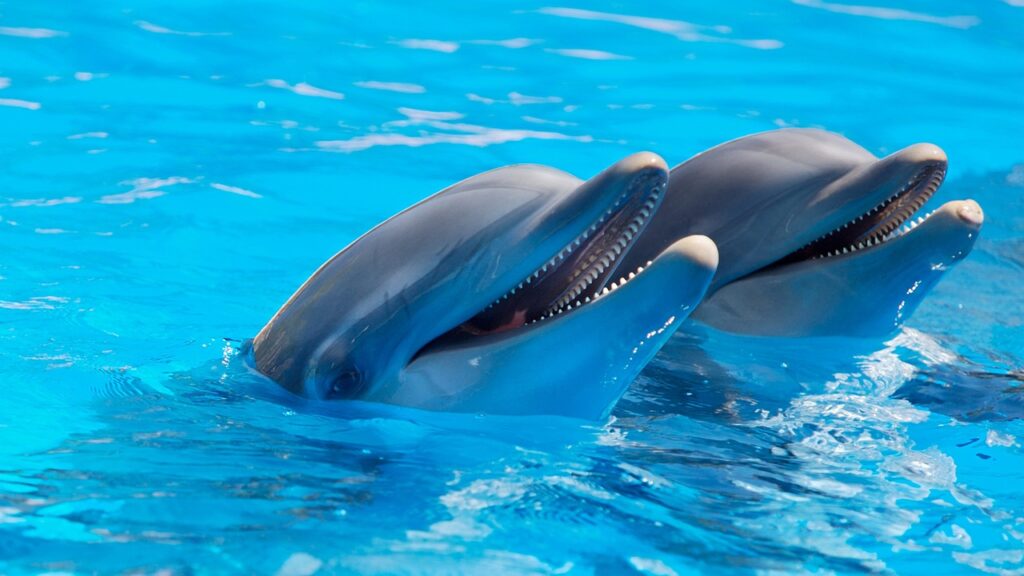
Dolphins are among the most beloved creatures in the ocean, captivating us with their intelligence, playful nature, and graceful movements. In this comprehensive guide, we’ll dive deep into the world of these remarkable marine mammals, exploring their characteristics, behavior, and the fascinating facts that make them unique.
Dolphins: Mammals of the Sea
What Makes Dolphins Mammals?
Despite their aquatic lifestyle, dolphins are indeed mammals, not fish. Here’s why:
- They’re warm-blooded, maintaining a constant body temperature
- They breathe air through lungs, coming to the surface to inhale through their blowholes
- They give birth to live young, rather than laying eggs
- They nurse their offspring with milk produced by mammary glands
- They have a small amount of hair, usually only visible in early stages of life
These characteristics firmly place dolphins in the mammal category, alongside humans, elephants, and bats.
Dolphins Animals: Behavior and Habitat
Dolphins are found in oceans worldwide and even in some rivers. They’re known for their:
- Playful behavior, often seen riding waves or bow-riding alongside boats
- High intelligence and problem-solving abilities
- Strong social bonds within their pods
- Use of echolocation for navigation and hunting
- Acrobatic displays, leaping high out of the water
Their streamlined bodies and powerful tails make them excellent swimmers, capable of reaching speeds up to 25 mph (40 km/h) in short bursts.
Are Dolphins Dangerous?
Generally, dolphins are not considered dangerous to humans. In fact, there are numerous accounts of dolphins helping humans in distress at sea. However, it’s crucial to remember that they are wild animals and should be treated with respect. Here are some key points to consider:
- In the wild, unprovoked attacks on humans are extremely rare
- Dolphins in captivity may occasionally show aggressive behavior, likely due to stress or improper handling
- It’s important to maintain a safe distance when observing dolphins in their natural habitat
- Never attempt to feed or touch wild dolphins, as this can alter their natural behavior and put both dolphins and humans at risk
What Do Dolphins Eat?
Dolphins are carnivores, with diets varying depending on their species and habitat. Their diet typically includes:
- Fish (such as herring, mackerel, and cod)
- Squid
- Octopuses
- Crustaceans (like shrimp and crabs)
Some larger dolphin species, such as orcas (killer whales), may also hunt seals, sea lions, and even other whales. Dolphins use their echolocation abilities to locate prey, often working together in pods to herd fish into tight groups for easier feeding.
Dolphins Schedule: Daily Life in the Ocean
While dolphins don’t follow a human-like schedule, they do have patterns in their daily activities:
- Feeding: Dolphins typically feed early in the morning and late in the afternoon
- Resting: They rest in short intervals throughout the day and night
- Socializing: Much of their day is spent interacting with pod members
- Travel: Dolphins may cover large distances in search of food or to reach breeding grounds
- Play: They engage in playful activities, which also serve as practice for hunting and social skills
It’s important to note that these patterns can vary based on factors such as species, habitat, and food availability.
Fascinating Dolphins Mammals Facts
To conclude our exploration of these amazing creatures, here are some intriguing facts about dolphins:
- Echolocation: Dolphins use sonar to navigate and hunt, emitting high-pitched sounds that bounce off objects in the water
- Sleep patterns: They sleep with one half of their brain at a time, allowing them to remain alert to potential dangers and breathe consciously
- Intelligence: Dolphins are considered one of the most intelligent animal species, with problem-solving abilities and complex social structures
- Communication: They use a variety of clicks, whistles, and body language to communicate with each other
- Diverse species: There are over 40 species of dolphins, ranging from the small 4-foot long Maui’s dolphin to the 30-foot long orca
- Long lifespan: Many dolphin species can live for 20-30 years, with some larger species living even longer
- Cultural transmission: Dolphins have been observed teaching skills to their young and passing on cultural behaviors within pods
Dolphins continue to amaze scientists and nature enthusiasts alike with their remarkable abilities and complex social lives. As we learn more about these extraordinary marine mammals, it becomes increasingly important to protect their habitats and ensure their survival for future generations to enjoy and study.